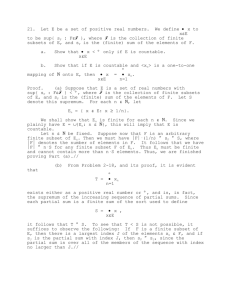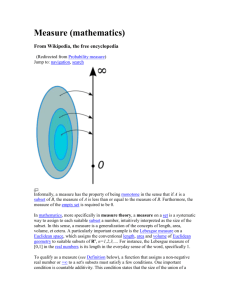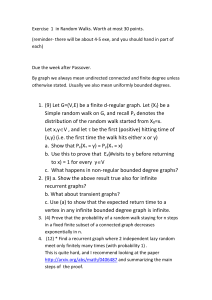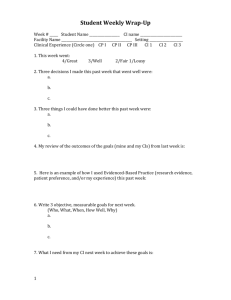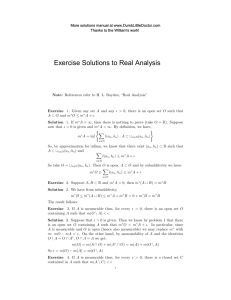Real Analysis HW 2 Solutions
advertisement
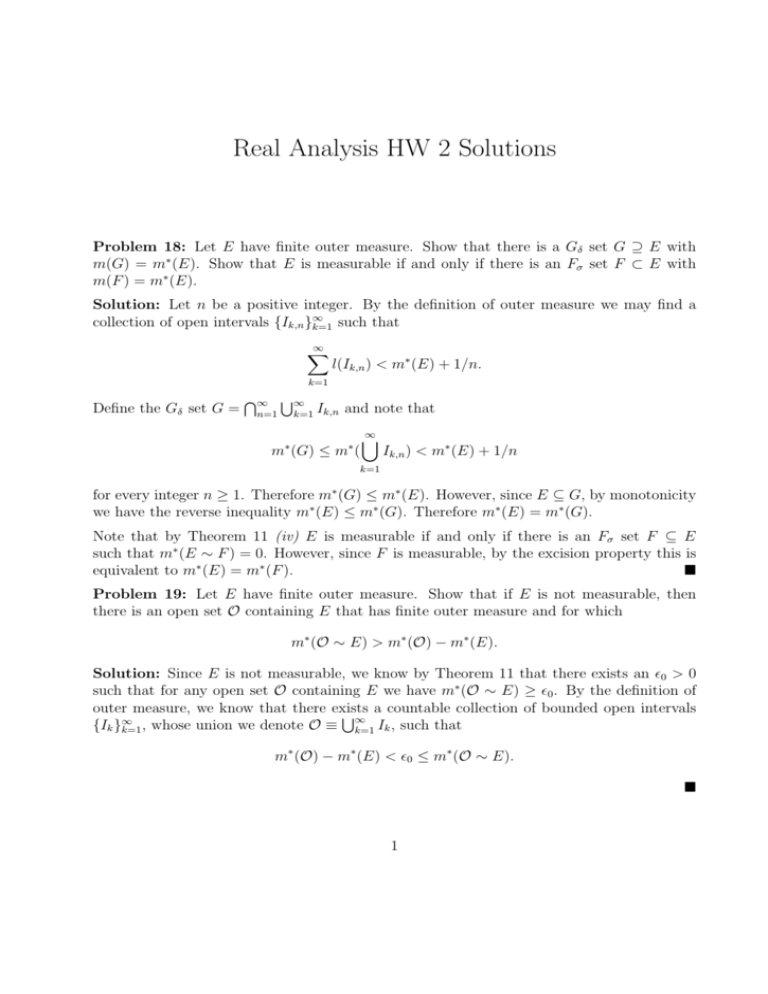
Real Analysis HW 2 Solutions
Problem 18: Let E have finite outer measure. Show that there is a Gδ set G ⊇ E with
m(G) = m∗ (E). Show that E is measurable if and only if there is an Fσ set F ⊂ E with
m(F ) = m∗ (E).
Solution: Let n be a positive integer. By the definition of outer measure we may find a
collection of open intervals {Ik,n }∞
k=1 such that
∞
X
l(Ik,n ) < m∗ (E) + 1/n.
k=1
Define the Gδ set G =
T∞ S∞
k=1 Ik,n
n=1
∗
and note that
∗
m (G) ≤ m (
∞
[
Ik,n ) < m∗ (E) + 1/n
k=1
for every integer n ≥ 1. Therefore m∗ (G) ≤ m∗ (E). However, since E ⊆ G, by monotonicity
we have the reverse inequality m∗ (E) ≤ m∗ (G). Therefore m∗ (E) = m∗ (G).
Note that by Theorem 11 (iv) E is measurable if and only if there is an Fσ set F ⊆ E
such that m∗ (E ∼ F ) = 0. However, since F is measurable, by the excision property this is
equivalent to m∗ (E) = m∗ (F ).
Problem 19: Let E have finite outer measure. Show that if E is not measurable, then
there is an open set O containing E that has finite outer measure and for which
m∗ (O ∼ E) > m∗ (O) − m∗ (E).
Solution: Since E is not measurable, we know by Theorem 11 that there exists an 0 > 0
such that for any open set O containing E we have m∗ (O ∼ E) ≥ 0 . By the definition of
outer measure, we know that there exists
S∞ a countable collection of bounded open intervals
∞
{Ik }k=1 , whose union we denote O ≡ k=1 Ik , such that
m∗ (O) − m∗ (E) < 0 ≤ m∗ (O ∼ E).
1
Problem 20: (Lebesgue) Let E have finite outer measure. Show that E is measurable if
and only if for each open, bounded interval (a, b),
b − a = m∗ ((a, b) ∩ E) + m∗ ((a, b) ∼ E).
Solution: Since the (Carathéodory) definition of measurability is immediately satisfied for
open bounded intervals, we simply need to show that if the measurability condition is satisfied
on all open bounded intervals, then E is measurable. Suppose that
m∗ ((a, b)) = m∗ ((a.b) ∩ E) + m∗ ((a.b) ∼ E)
holds for every bounded interval (a, b). Let > 0, since E has finite outer measure we know
that there is a countable collection of bounded open intervals Ik such that
∞
X
m∗ (Ik ) < m∗ (E) + .
k=1
Since Ik is open and bounded, we have
m∗ (Ik ) = m∗ (Ik ∩ E) + m∗ (Ik ∼ E).
Upon summing both sides and using countable sub-additivity
∞
X
∗
m (Ik ) =
∞
X
∗
m (Ik ∩ E) +
∗
≥m
∞
[
m∗ (Ik ∼ E)
!k=1
k=1
k=1
∞
X
(Ik ∩ E)
∗
+m
k=1
Denoting O ≡
we find
S∞
k=1 Ik
m (E) + >
∞
X
!
(Ik ∼ E) .
k=1
and using the fact that E =
∗
∞
[
S∞
k=1 Ik ∩E
and
S∞
k=1 (Ik
∼ E) = O ∼ E,
m∗ (Ik ) ≥ m∗ (E) + m∗ (O ∼ E).
k=1
Therefore
m∗ (O ∼ E) < ,
which by Theorem 11 is equivalent to the measurability of E.
Problem 24: Show that is E1 and E2 are measurable, then
m(E1 ∪ E2 ) + m(E1 ∩ E2 ) = m(E1 ) + m(E2 ).
Solution: Note that if either E1 or E2 have infinite measure then the inequality trivially
holds. Assume that E1 and E2 have finite measure. Note that we may write E1 ∪ E2 as a
2
disjoint union E1 ∪ E2 = (E1 ∩ E2 ) ∪ (E1 ∼ (E1 ∩ E2 )) ∪ (E2 ∼ (E1 ∩ E2 )). By finite additivity
and excision,
m(E1 ∪ E2 ) = m(E1 ∩ E2 ) + m(E1 ∼ (E1 ∩ E2 )) + m(E2 ∼ (E1 ∩ E2 ))
= m(E1 ∩ E2 ) + m(E1 ) − m(E1 ∩ E2 ) + m(E2 ) − m(E1 ∩ E2 )
= m(E1 ) + m(E2 ) − m(E1 ∩ E2 ).
Problem 27: Let M0 be any σ-algebra of subsets of R and m0 a set function on M0 which
takes values in [0, ∞], is countably additive, and such that m0 (∅) = 0.
(i) Show that m0 is finitely additive, monotone, countably monotone, and possesses the
excision property
(ii) Show that m0 possesses the same continuity properties as Lebesgue measure.
Solution:
(i) Finite additivity follows trivially from countable additivity, since we may consider
collections of sets for which only finitely many are non-empty. To prove excision and
monotonicity, suppose A, B ∈ M0 with B ⊆ A. Since we can write A as a disjoint
union A = (A ∼ B) ∪ B. Therefore by finite additivity
m0 (A) = m0 (A ∼ B) + m0 (B).
This proves both monotonicity and excision since m0 (A ∼ B) ≥ 0.
0
To prove countable monotonicity we let {Ek }∞
k=0 ⊆ M be a collection of sets that
covers some set E ∈ M0 . As usual we define A0 = E0 and for n ≥ 1,
An = En ∼
n−1
[
Ek ,
k=1
S
S∞
so that {An } are disjoint,An ⊆ En and ∞
k=0 Ak =
k=0 Ek . Using countable additivity
and monotonicity
!
!
∞
∞
∞
∞
[
[
X
X
0
0
0
0
m (E) ≤ m
Ek = m
Ak =
m (Ak ) ≤
m0 (Ek ).
k=0
k=0
k=0
k=0
(ii) The proof is identical to the proof of in the case of Lebesgue, which relies on the
properties of monotonicity, countable additivity, and the excision property.
3
Problem 28: Show that continuity of measure together with finite additivity of measure
implies countable additivity of measure.
Sn
Solution: Let {Ek }∞
of
measurable
sets.
Define
A
=
n
k=1 be a disjoint collection
k=1 Ek ,
S∞
S∞
∞
and note that {An }k=1 is ascending and that k=1 An = k=1 En . Continuity of measure
then implies
!
!
∞
∞
[
[
m
Ek = m
Ak = lim m(An ).
k=1
n→∞
k=1
However by finite additivity
lim m(An ) = lim
n→∞
n→∞
Therefore
m
∞
[
n
X
m(Ek ) =
k=1
!
Ek
=
k=1
∞
X
m(Ek ).
k=1
∞
X
m(Ek ).
k=1
4
![MA2224 (Lebesgue integral) Tutorial sheet 4 [February 12, 2016] Name: Solutions](http://s2.studylib.net/store/data/010730671_1-f6e140ab17700643175ac1e9e5d7377a-300x300.png)
